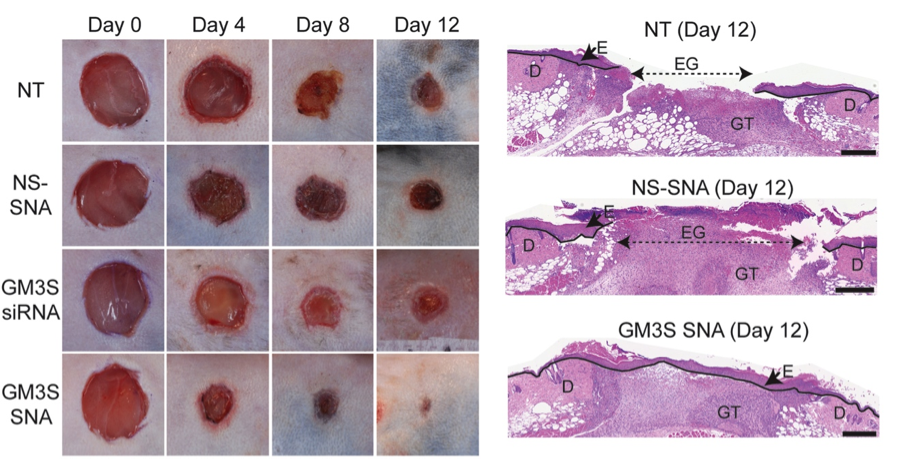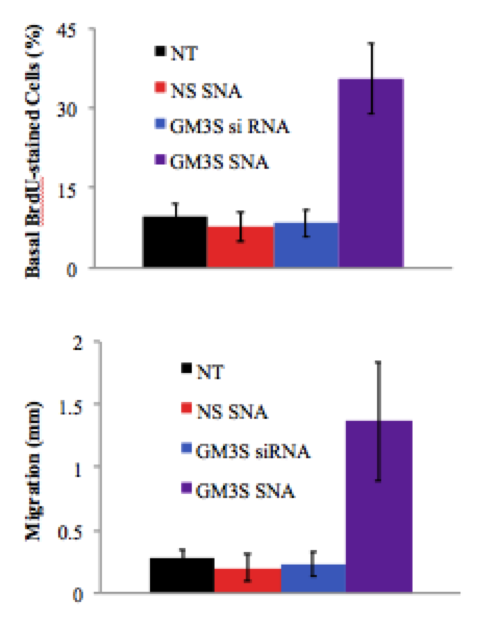Presenting Author:
Principal Investigator:
Amy Paller, M.D.
Department:
Dermatology
Keywords:
wound healing, diabetes, SNAs, GM3 synthase
Location:
Third Floor, Feinberg Pavilion, Northwestern Memorial Hospital
B22 - Basic Science
Knocking down ganglioside GM3S promotes wound healing
Summary: Gene suppression to target components of signaling pathways has become an increasingly effective and attractive tool for skin disease therapy. Spherical nucleic acids (SNAs) are a novel technology, in which siRNA or antisense DNA is densely distributed in a spherical configuration around a central gold nanoparticle. SNAs are able to penetrate the epidermal barrier without ancillary measures or toxicity and specifically knock down the expression of target genes. Ganglioside-monosialic acid 3 synthase (GM3S) is a recognized mediator of insulin resistance that is overexpressed in diabetes and impairs wound healing. siRNA-based GM3S SNAs knock down the expression of GM3S mRNA and protein in cultured keratinocytes and skin of diabetic mouse models. In the current study, we showed that topical application of GM3S SNAs on 6mm diameter wounds in diet induced obese (DIO) and ob/ob mouse models accelerated wound closure, increased cell proliferation and migration, and improved vascularization. Topical application of SNAs directed against the GM3S pathway could represent a new method of treatment for diabetic wound healing. The nanoparticle delivery system can be a powerful tool for a variety of suppressive therapies as it can be used to target a range of skin disorders with activated signaling pathways. Methods: Diet induced obese mice and ob/ob mouse diabetic models were treated with NS SNA (vehicle), free GM3S siRNA, and GM3S SNAs. These mice were compared to non treated (NT) controls. Wound closure was assessed by quantifying the maximal gap between leading edges of epidermal migration. Proliferation was assessed by immunohistochemistry staining of bromodeoxyuridine (BrdU) in mouse wound tissue sections. Migration distance along the length of the basement membrane and granulation tissue verified by CD31 staining were quantified. Measurements were made using HistoQuest and NIH ImageJ program. Results: GM3S SNA treated wounds were clinically healed by 12 days after wounding. Significant reduction in epidermal gap relative to control treated wounds was first observed by 6 days after initiation of SNA treatment. GM3S SNA treated wounds have significantly more BrdU stained cells indicating greater cell proliferation and have greater migration distance when compared to controls. Dermal CD31 expression almost doubles in GM3S SNA treated wounds. Conclusions: GM3S knock down via SNAs accelerates would closure and reepithelization, increases cell proliferation and migration and promotes vascularization in granulation tissue. GM3S SNA normalizes diabetes induced wound healing impairment and the data further validate GM3 as a mediator of delayed wound healing in type 2 diabetes. SNAs, which specifically and efficiently knock down target genes, are a potential topically applied therapeutic approach to not only improve wound healing but also treat any skin related disease with a genetic basis.


